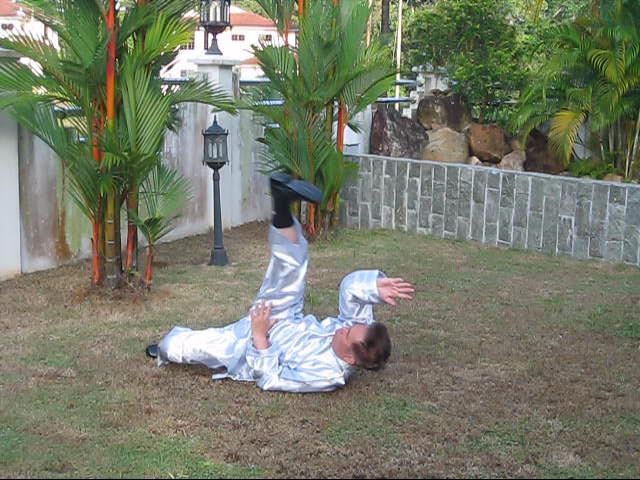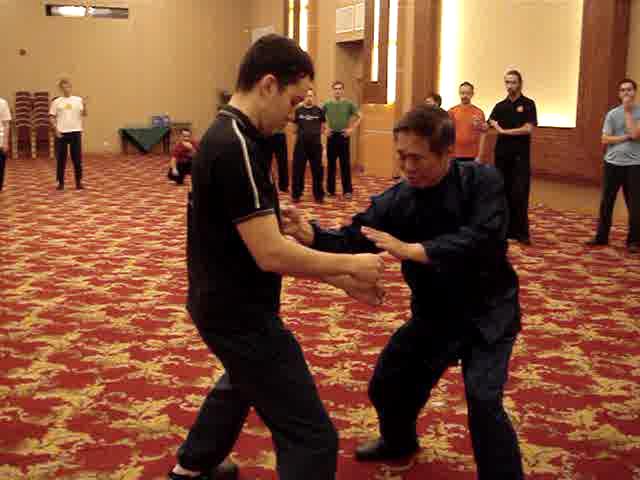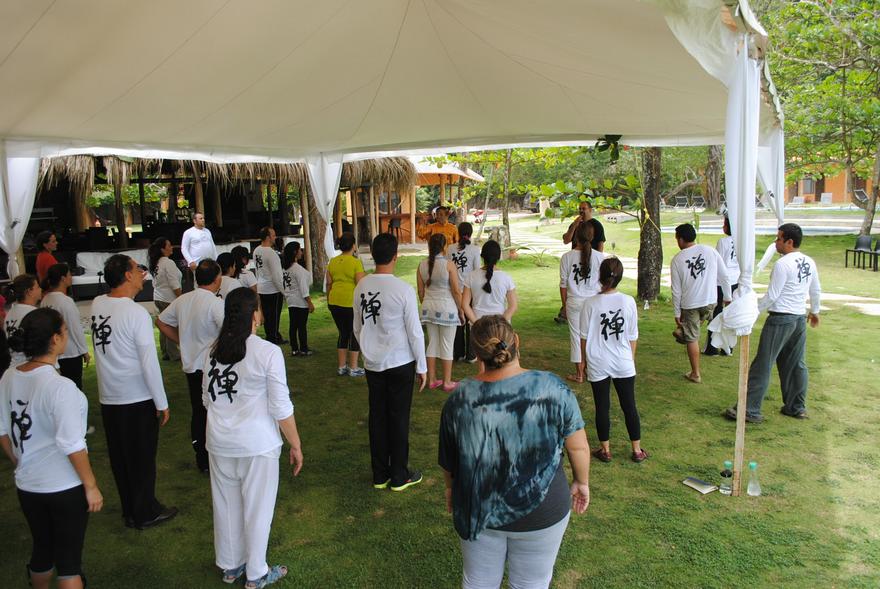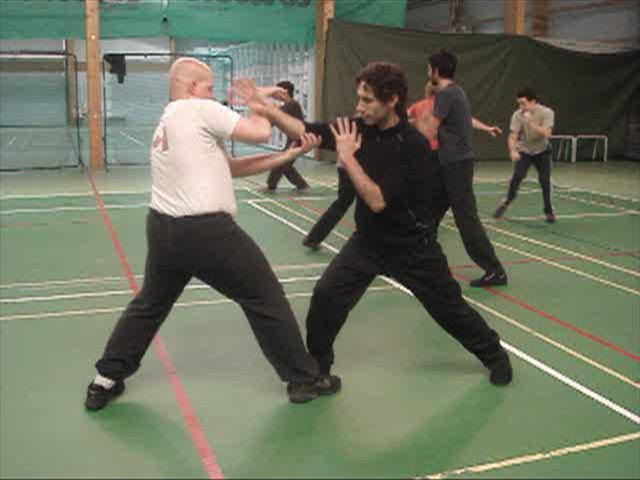SELECTION OF QUESTIONS AND ANSWERS
AUGUST 2012 PART 3

A pattern from the Drunken Eight Immortals
Question 1
Sifu, you have mentioned that even when one has access to kungfu classics, he may not understand it. Can you please elaborate?
-- Sifu Anthony Spinicchia, USA
Answer
Kungfu classics are rare nowadays, but even when one has access to it he may not really understand what is written due to the following three reasons.
Firstly, kungfu classics are written in classical Chinese, which is a very concise language. Even those well versed in modern Chinese may not understand classical Chinese.
The difficulty is compounded by the fact that the classical language is written in traditional characters, which are different from modern, simplified characters. The whole of China today, and most Chinese overseas use modern, simplified Chinese characters.
Here is one example, taken from the beginning of "Illustrated Explanation of Shaolin Principles and Techniques", and translated literally as follows.
-
Soft method's different schools, those practice so diverse. Thus energy art be first cultivation principle. Spirit art be essence of practice.
Investigate its extreme, arrive at return. Eventually study and enjoy Zen opportunities. Escape and surpass life death fear city.
After that big enemy in front, spear halberd behind, heart not swayed moved by this, energy start be strengthened. So said Tai Mountain tumbles down on my side, East Sea flows in to my right, emperor heart remains natural.
Like in many classics, the starting is very important; it highlights the basic philosophy of the whole work. It also states the basic philosophy of our school.
Explained in modern language, the meaning is as follows.
-
There are many different schools of internal arts, and those who practice these different internal arts are also very diverse. Thus, even if they practice the same art, their methods and results can be very different.
Despite the diversity of the arts as well the practitioners, the cultivation of qi or energy forms the basis. In other words, irrespective of what internal arts they practice and who the practitioners are, the basis is to cultivate energy.
The basis of practice is meditation, or cultivation of mind. In other words, irrespective of the particular methods used in the cultivation of energy, one must be in a meditative state of mind. In simple language it means the practitioners is mentally relaxed and not thinking of any thing.
One must understand that the end or aim of the practice is not just going over the techniques, but to obtain the results. The ultimate aim and result is to attain Zen, or the Supreme Cosmic Reality, to be liberated from and go beyond the phenomenal world of countless lives, deaths and rebirths. In the eyes of Shaolin monks who have denounced worldly pleasures to cultivate for the highest spiritual goal, the phenomenal world is described as fearful compared to the eternal bliss of Enlightenment.
The supreme aim of the internal arts is to cultivate for Enlightenment. After that, one may cultivate for combat. Even when you face formidable opponents, with weapons around, you can remain calm and relaxed, and your energy can sustain you from the start till the end of combat. As the saying goes, 'Even if Tai Mountain tumbles down to your side, and the Eastern Sea flows in to your right', you remain calm and relaxed as in normal condition.
Secondly, kungfu classics are not teaching manuals. The material in kungfu classics is meant for practitioners who have undergone the training, or meant for posterity who are expected to learn the art from living, competent teachers. In the quotation above, for example, it is just mentioned that the basis of internal art is cultivating energy, but how to do it is not explained.
Even when it is explained, only the core instructions particularly related to the practice are given, and are stated in very concise language. Unlike in teaching manuals where instructions are given clearly and in details, in kungfu classics fundamental instructions which practitioners are expected to know but may be crucial to the practice, are usually not mentioned.
An excellent example is the "Shaolin 72 Arts". This classic, in its different versions, is now available to the public in English, and many people have practiced some of these 72 arts from the book. What they don't realize is that without the basic knowledge of force training, which is not mentioned in the book, even when they follow the stated instructions correctly, not only they may not acquire the arts but they may have adverse effects instead.
The following are the instructions to train Iron Arm. I have translated the instructions in the context of a modern language. In a classical language context, the starting line would be "Prepare pole. Strike all sides."
-
Prepare a wooden pole. Gently strike the pole with your arms. Strike all sides. Start with tens of times, then increase to hundreds, and eventually thousands. Eventually strike with full force. Then change to striking trees, then to striking stone pillars.
The instructions are correct. But unless one learns personally from a competent teacher or is himself initiated into internal force training, even when his arms become powerful, they are nothing like the Iron Arm this specialized art is meant to produce. Worse, he would probably develop adverse effects that he himself may not know.
Why? Because he lacks the basic knowledge, which includes the stances to adopt while striking, not tensing his muscles, how to regulate his breathing, how to be in a meditative state of mind, and the application of chi flow or medication to remedy injuries.
I have purposely chosen as an example an art using relatively external methods with straight-forward instructions. You can imagine how more difficult it will be with an art that is more internal with sophisticated instructions.
The third reason why one may not understand it and therefore cannot acquire the art described even when he has access to a kungfu classic is that he is unable to carry out the instructions even when he knows the instructions.
Let us now take an example from a Taijiquan classic, "Introduction to Cosmos Taijiquan", which lists the following "Ten Great Principles of Taijiquan". Again, I have translated the ten principles in a modern language context. In a classic language context, the starting words would be "Empty spirit top force", which may be meaningless to many people. In terms of linguistic factors, because they were written later, Taijiquan classics are generally easier to be understood than Shaolin classics.
- Empty mind, full of force, energy sinks to dan tian.
- Subdue chest, expose back, intention fills the internal.
- Drop shoulders, sink elbows, loosen bones and tendons.
- Loosen waist, open hips, rotate the feet.
- Use intention to lead energy, attain spiral force.
- Differentiate false real, harmonize yin yang.
- Top bottom connected, internal external harmonized.
- Loose, slow, round, gentle, contact, continuous, sticking.
- Patterns flowing thousands of techniques.
- Quiescence in motion natural way.
It is ironical that today many Taiji instructors quote these principles to glamorize their reputation and may understand the dictionary meaning of the principles, but do not really know what they mean because they are unable to carry out the instructions to have a direct experience of the principles.
For example, they may know that they should empty their mind, yet they are troubled by countless thoughts in both their practice and in daily life. They know that Taijiquan training should fill them with internal force, yet they feel weak and tired. They know they should sink their energy to their dan tian, but do not know how to do it. They may not even know what qi or energy is, because they never have any qi experience.
Question 2
I absolutely love the Eight Drunken Immortals form that you have compiled, but I was wondering since you learned the traditional Wudang set and Wing Choon, will you be making those available as well?
— Joseph, USA
Answer
The Drunken Eight Immortals Set is my composition based on the signature technique of each of the Eight Immortals which I learned from Sifu Ho Fatt Nam, and also based on the Drunken Eight Immortals Set from Choe Family Wing Choon Kungfu which I learned from Sifu Choe Hoong Choy. It is a set loved by many instructors and students in our school, and is considered by some as the most complete kungfu set as it contains everything, including a lot of floor work.
The Wudang Taijiquan Set is a reconstruction based on Taijiquan classics and other sources. Besides being the source of Taijiquan, it also represents the pinnacle of Shaolin kungfu development where the great Zhang San Feng integrated kungfu, chi kung and meditation into one unity. It was one of the two most favorite choices as a selective set (the other being the Flower Set) by participants in a recent Speical Shaolin-Taijiquan course conducted in October 2011 in Sabah, Malaysia.
I learned the fundamental Wing Choon set, called Siu Lin Tou or "Little-Practice-Beginning", from Sifu Choy Hoong Choy more than 30 yeears ago. It was a long set incorporating what in other Wing Choon schools would be the three sets of Siu Lim Tou (Little-Thought-Beginning), Cham Kiew (Seeking Bridge) and Phew Chee (Thrusting Fingers). But in our school, Shaolin Wahnam, I teach this long set as three sets, namely Siu Lin Tou, Cham Kiew and Phew Chee.
I did not learn Siu Lin Tou in a normal way, which would take many months or even years. Sifu Choe Hoong Choy "gave" the set to me in just a few days! While I had the advantage of speed, the disadvantage was that the routine of the set could be easily forgotten. I overcame this setback by recording the names of the patterns in a note book.
However, years later when I tried to reconstruct the set from the notes, I might not have the patterns the exact way I learned them. Moreover I also made some modifications to the set according to my needs. Hence, the Siu Lin Tou set practiced in Shaolin Wahnam today may not be the same as the one practiced by other Wing Choon practitioners even if they also come from Sifu Choe Hoong Choy's lineage.
The three beautiful sets, Drunken Eight Immortals, Wudang Taijiquan and Siu Lin Tou, are presented in videos and can be accessed at this webpage on kungfu sets.

Sifu Mark Blohm and Grandmaster Wong Kiew Kit applying Wing Choon Kungfu in combat
Question 3
I am contacting you because I have suffered 12 years from migraines. Sometimes it was so intense and lasted a week and a half that I found it unbearable. Please indicate any specific, ideal exercises.
— Isidro, Spain
Answer
Migraine can be easily overcome if you practice genuine chi kung. It needs not even be advanced or powerful chi kung, but it must be genuine. By genuine I mean that the chi kung must generate a chi flow.
I am going to tell you a big secret. As overcoming migraine is not a big issue in chi kung, it is not what chi kung technique or exercise you practice that is important. What is important is that you are able to generate a chi flow.
Chi flow is the essence of chi kung. If there is no chi flow, you do not practice the technique or exercise as chi kung; you only practice it as physical exercise, and physical exercise cannot overcome your migraine.
An analogy will make this clear. Suppose you want to buy a shirt costing 50 euros but you do not have any money. This is only a small economic problem, not a big one.
You need to work on a job that generates a cash flow. Most jobs will pay you more than 50 euros, and with the cash flow you can overcome your small economic problem of buying a shirt. It is not what job you do that is important. The important thing is that your job must generate a cash flow.
It is the cash flow, not the job, that enables you to overcome your economic problem. If you work but do not have a cash flow, then your work is not a paying job; it is free service, and free service would not enable you to overcome your economic problems.
Similarly, if you practice a chi kung exercise but there is no chi flow, it is not genuine chi kung, it is gentle physcial exercise, and gentle physical exercise does not overcome your health problems.
Question 4
I could not attend any courses due to financial problems. But through your books I try to practice qigong the best I can.
Answer
If you can generate a chi flow by practicing from my books, you will be able to overcome your migraine. But it is easier and also cheaper if you learn from one of our certified chi kung instructors. We have many certified chi kung instructors in Spain. Please see our List of Certified Instructors.
How you are going to use your money is of course your business, but it strikes me as being silly someone who has suffered from migraine for 12 years and at times unbearable but unwilling to find some money to learn a high-level art that will not only overcome his migraine but also gives him good health and zest for life.

It is the chi flow, not the technique, that gives good health, vitality and longevity
Question 5
I would love to meet you and to learn from you.
Answer
Many people have told me the same thing, and they are usually sincere in their intention, but what they have missed saying, and which they themselves may not be fully aware is the unspoken condition, "if it does not cause me any inconvenience or financial commitment."
Question 6
I was searching for different types of alternative exercises to improve the sport I practice, I discovered the existence of chi kung. I bought and read Sifu Wong Kiew Kit's book, "Chi Kung for Health and Vitality". Unfortunately, I could not find a master for this technique of chi kung, so I have to practice it just with the book by myself. (I did find some masters, but they teach other types of chi kung.) I live in Colombia, South America. I don't think we have Shaolin chi kung masters here.
— Luis, Colombia
Answer
Shaolin Wahnam Colombia is a very important part of our Shaolin Wahnam International Family. In fact Colombia was the first country where we brought our arts to Latin and South America.
Sifu Rama, who is the Chief Instructor of Latin America, and Sifu Piti, who is the main Instructor in Colombia, are well known for teaching top leaders in Colombia, including many presidents of international corporations. Please see our List of Certified Instructors for our instructors in Colombia.

Shaolin Wahnam students can spar for a few hours without panting for breaths or feeling tired
Question 7
The sport I practice is free-diving. This is a sport very different from others as to using physical force. Although the physical training sessions are very tough, the competitions have to be very "soft" and slow in order to save air.
Free-diving is divided into two big groups:
- In the Sea. The objective is to swim as deep as possible into the sea and go back to the surface with just one breath.
- In a Pool. Swiming underwater as long as possible searching for the maximum distance with just one breath.
The training for this sport is not only physical. We also have to train concentration, relaxation, stretching, breathing, visualization, mind, etc. In fact, free-diving is 70% on mind and 30% physical.
Answer
Chi Kung is excellent for your sport. It gives you a lot of energy so that you can swim for a very long distance with just one breath, and it also makes you "soft" so that you can perform demanding exercises without having to tense your muscles.
With chi kung many of our students can run round a football field without panting for breath and without being tired. You can transfer the skills to free-diving.
Training in the internal arts will benefit free-diving or any sport tremendously. Our Shaolin and Taijiquan students can spar vigorously for hours without being out of breath or being tired. They need to be relaxed and focused at the same time, make right decisions quickly, and response spontaneously and correctly to opponents' movements. When you transfer these skills to your sport, you have the making of a champion.
Question 8
I really want to become a champion in this sport, so the question I have is the following: Chapter 15 of Chi Kung for Health and Vitality recommends exercises for people training sports, but I see that those exercises are adequate for sports that need real physical force (excluding the visualization exercise). Apart from meditation and visualization, please recommend for me chi kung exercises for my particular sport.
Answer
You may find my answer odd, but speaking in my capacity as a chi kung grandmaster, it is the best answer for you.
Any chi kung exercise will be good for you. The important consideration is not what exercise you perform, but whom you learn from and how you yourself practice the exercise.
I would strongly recommend that you learn from Sifu Piti or Sifu Rama. They are two of the best chi kung teachers you can find anywhere. Later you should attend my Intensive Chi Kung Course. Please see my website for available dates.
If you follow my advice, you will not only do well in your chosen sport, but also do well in whatever you do. This is no surprise if you realize that with a tremendous improvement of energy and mind, which our chi kung training will provide, anything you do will improve tremendously. More importantly, you will have good health, vitality, longevity and joy in your daily life.
In other words, do not just seek which exercise can make your body softer, and which exercise can enable you to hold your breath longer, so that you can do better in free-diving. Rather, seek to increase your energy and mind power so that you can do anything better.
As an analogy, do not just seek which shop will give you a cheaper price, and which employer will give you a higher pay so that you can buy more free-diving equipments. Rather seek to increase your cash flow and bank account so that you are in a better position to buy anything you want.
If you wish to know how you can improve your cash flow and bank account, you have to work that out yourself. But I am certain that Sifu Piti or Sifu Rama can help you to improve your energy and mind tremendously.
LINKS
Selected Reading
- Taijiquan Treatise of Zhang San Feng!
- Secrets of the Twelve Bridges
- Shaolin Kungfu against Wester Boxing
- Good Health is Our Birth-Right
- To Prove that Qi is Real and Qigong is Not a Fake Healing Art
